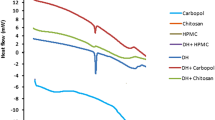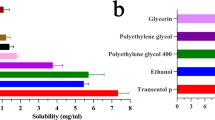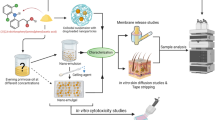ABSTRACT
The aim of this work was to study the potential of delivering clindamycin phosphate, as an efficient antibiotic drug, into a more absorbed, elastic ultradeformable form, transfersomes (TRSs). These vesicles showed an enhanced penetration through ex vivo permeation characters. TRSs were prepared using thin-film hydration method. Furthermore, they were evaluated for their entrapment efficiency, size, zeta potential, and morphology. Also, the prepared TRSs were converted into suitable gel formulation using carbopol 934 and were evaluated for their gel characteristics like pH, viscosity, spreadability, homogeneity, skin irritation, in vitro release, stability, and ex vivo permeation studies in rats. TRSs were efficiently formulated in a stable bilayer vesicle structure. Furthermore, clindamycin phosphate showed higher entrapment efficiency within the TRSs reaching about 93.3% ± 0.8 and has a uniform particle size. Moreover, the TRSs surface had a high negative charge which indicated the stability of the produced vesicles and resistance of aggregation. Clindamycin phosphate showed a significantly higher in vitro release (p < 0.05; ANOVA/Tukey) compared with the control carbopol gel. Furthermore, the transfersomal gel showed a significantly higher (p < 0.05; ANOVA/Tukey) cumulative amount of drug permeation and flux than both the transfersomal suspension and the control carbopol gel. In conclusion, the produced results suggest that TRS-loaded clindamycin are promising carriers for enhanced dermal delivery of clindamycin phosphate.






Similar content being viewed by others
REFERENCES
Andremont A, Lancar R, Le An N, Hattchouel JM, Baron S, Tavakoli T, et al. Secular trends in mortality associated with bloodstream infections in 4268 patients hospitalized in a cancer referral center between 1975 and 1989. Clin Microbiol Infect. 1996;1(3):160–7.
Touitou E, Dayan N, Bergelson L, Godin B, Eliaz M. Ethosomes—novel vesicular carriers for enhanced delivery: characterization and skin penetration properties. J Control Release. 2000;65(3):403–18.
Duangjit S, Opanasopit P, Rojanarata T, Ngawhirunpat T. Evaluation of meloxicam-loaded cationic transfersomes as transdermal drug delivery carriers. AAPS PharmSciTech. 2013;14(1):133–40.
GC IL, Wurtman RJ. Enhancement by cytidine of membrane phospholipid synthesis. J Neurochem. 1992;59(1):338–43.
El Maghraby GM, Williams AC, Barry BW. Skin delivery of oestradiol from deformable and traditional liposomes: mechanistic studies. J Pharm Pharmacol. 1999;51(10):1123–34.
El Maghraby GM, Williams AC, Barry BW. Oestradiol skin delivery from ultradeformable liposomes: refinement of surfactant concentration. Int J Pharm. 2000;196(1):63–74.
Zheng WS, Fang XQ, Wang LL, Zhang YJ. Preparation and quality assessment of itraconazole transfersomes. Int J Pharm. 2012;436(1–2):291–8.
Elsayed MM, Abdallah OY, Naggar VF, Khalafallah NM. Deformable liposomes and ethosomes: mechanism of enhanced skin delivery. Int J Pharm. 2006;322(1–2):60–6.
Alvi IA, Madan J, Kaushik D, Sardana S, Pandey RS, Ali A. Comparative study of transfersomes, liposomes, and niosomes for topical delivery of 5-fluorouracil to skin cancer cells: preparation, characterization, in-vitro release, and cytotoxicity analysis. Anti-Cancer Drugs. 2011;22(8):774–82.
Duangjit S, Opanasopit P, Rojanarata T, Ngawhirunpat T. Characterization and in vitro skin permeation of meloxicam-loaded liposomes versus transfersomes. J Drug Delivery. 2011;2011:418316.
Schatzlein A, Cevc G. Non-uniform cellular packing of the stratum corneum and permeability barrier function of intact skin: a high-resolution confocal laser scanning microscopy study using highly deformable vesicles (transfersomes). Br J Dermatol. 1998;138(4):583–92.
Malakar J, Sen SO, Nayak AK, Sen KK. Formulation, optimization and evaluation of transferosomal gel for transdermal insulin delivery. Saudi Pharm J. 2012;20(4):355–63.
Duangjit S, Obata Y, Sano H, Onuki Y, Opanasopit P, Ngawhirunpat T, et al. Comparative study of novel ultradeformable liposomes: menthosomes, transfersomes and liposomes for enhancing skin permeation of meloxicam. Biol Pharm Bull. 2014;37(2):239–47.
Gupta A, Aggarwal G, Singla S, Arora R. Transfersomes: a novel vesicular carrier for enhanced transdermal delivery of sertraline: development, characterization, and performance evaluation. Sci Pharm. 2012;80(4):1061–80.
Akarsu S, Fetil E, Yucel F, Gul E, Gunes AT. Efficacy of the addition of salicylic acid to clindamycin and benzoyl peroxide combination for acne vulgaris. J Dermatol. 2012;39(5):433–8.
Borglund E, Hagermark O, Nord CE. Impact of topical clindamycin and systemic tetracycline on the skin and colon microflora in patients with acne vulgaris. Scand J Infect Dis Suppl. 1984;43:76–81.
van Hoogdalem EJ. Transdermal absorption of topical anti-acne agents in man; review of clinical pharmacokinetic data. J Eur Acad Dermatol Venereol. 1998;11 Suppl 1:S13–9. discussion S28-9.
Jivrani Shilpa DPVK. Formulation, development and evaluation of niosomal drug delivery system for clindamycin phosphate. Pharma Sci Monitor. 2014;5(1):256–74.
Akhavan A, Bershad S. Topical acne drugs: review of clinical properties, systemic exposure, and safety. Am J Clin Dermatol. 2003;4(7):473–92.
Castro GA, Ferreira LA. Novel vesicular and particulate drug delivery systems for topical treatment of acne. Expert Opin Drug Deliv. 2008;5(6):665–79.
Shanmugam S, Song CK, Nagayya-Sriraman S, Baskaran R, Yong CS, Choi HG, et al. Physicochemical characterization and skin permaetion of liposome formulations containing clindamycin phosphate. Arch Pharm Res. 2009;32(7):1067–75.
Huang ZJ, Li T, Guo XJ, Wang YT, Yang MQ, Huang SL, et al. Technical study of vinpocetine micelles prepared by thin-film hydration method. Zhong Yao Cai. 2012;35(11):1850–4.
Berger N, Sachse A, Bender J, Schubert R, Brandl M. Filter extrusion of liposomes using different devices: comparison of liposome size, encapsulation efficiency, and process characteristics. Int J Pharm. 2001;223(1–2):55–68.
Destremaut F, Salmon JB, Qi L, Chapel JP. Microfluidics with on-line dynamic light scattering for size measurements. Lab Chip. 2009;9(22):3289–96.
Leung AB, Suh KI, Ansari RR. Particle-size and velocity measurements in flowing conditions using dynamic light scattering. Appl Opt. 2006;45(10):2186–90.
Abdellatif AAH, El Rasoul SA, Osman S. Gold nanoparticles decorated with octreotide for somatostatin receptors targeting. Int J Pharm Sci Res. 2015;7(1):14–20.
Mahmoud EA, Bendas ER, Mohamed MI. Effect of formulation parameters on the preparation of superporous hydrogel self-nanoemulsifying drug delivery system (SNEDDS) of carvedilol. AAPS PharmSciTech. 2010;11(1):221–5.
Osman SK, Soliman GM, El Rasoul SA. Physically cross-linked hydrogels of beta -cyclodextrin polymer and Poly(ethylene glycol)-cholesterol as delivery systems for macromolecules and small drug molecules. Curr Drug Deliv. 2015;12(4):415–24.
Liberman HA RM, Banker GS. Pharmaceutical dosage form, disperse systems. 1989.
Misal GD, Gouri, Gulkari V. Formulation and evaluation of herbal gel. Indian J Nat Prod Res. 2012;3(4):501–5.
Shivhare UD, Jain KB, Mathur VB, Bhusari KP, Roy AA. Formulation development and evaluation of diclofenac sodium gel using water soluble polyacrylamide polymer digest. Int J Nano Biomater. 2009;4(2):285–90.
Ammar HO, Ghorab M, El-Nahhas SA, Higazy IM. Proniosomes as a carrier system for transdermal delivery of tenoxicam. Int J Pharm. 2011;405(1–2):42–152.
Pillai O, Panchagnula R. Transdermal delivery of insulin from poloxamer gel: ex vivo and in vivo skin permeation studies in rat using iontophoresis and chemical enhancers. J Control Release. 2003;89(1):127–40.
Gacek MM, Berg JC. Effect of surfactant hydrophile-lipophile balance (HLB) value on mineral oxide charging in apolar media. J Colloid Interface Sci. 2015;449:192–7.
Ravouru N, Kondreddy P, Korakanchi D, Haritha M. Formulation and evaluation of niosomal nasal drug delivery system of folic acid for brain targeting. Curr Drug Discov Technol. 2013;10(4):270–82.
Ghanbarzadeh S, Arami S. Enhanced transdermal delivery of diclofenac sodium via conventional liposomes, ethosomes, and transfersomes. Biomed Res Int. 2013;2013:616810.
Vieville J, Tanty M, Delsuc MA. Polydispersity index of polymers revealed by DOSY NMR. J Magn Reson. 2011;212(1):169–73.
Aghajani M, Shahverdi AR, Amani A. The use of artificial neural networks for optimizing polydispersity index (PDI) in nanoprecipitation process of acetaminophen in microfluidic devices. AAPS PharmSciTech. 2012 Sep 21.
Liu X, Xu H, Xia H, Wang D. Rapid seeded growth of monodisperse, quasi-spherical, citrate-stabilized gold nanoparticles via H2O2 reduction. Langmuir. 2012;28(38):13720–6.
Greenwood R. Review of the measurement of zeta potentials in concentrated aqueous suspensions using electroacoustics. Adv Colloid Interf Sci. 2003;106:55–81.
Ali MF, Salem HF, Abdelmohsen HF, Attia SK. Preparation and clinical evaluation of nano-transferosomes for treatment of erectile dysfunction. Drug Des Devel Ther. 2015;9:2431–47.
Arora G, Malik K, Singh I, Arora S, Rana V. Formulation and evaluation of controlled release matrix mucoadhesive tablets of domperidone using Salvia plebeian gum. J Adv Pharm Technol Res. 2011;2(3):163–9.
Kirajavainen M MJ, Saukkasaari M, Valjakka-Koskela R, Kiesvaara J. Phospholipids affects stratum corneum lipid bilayer fluidity and drug partitioning into the bilayers. In: Release JC, editor; 1999. p. 58:207–14.
ACKNOWLEDGMENTS
The authors would like to thank Zobida Hassan, N. Elsaid, R. Abdelaal, and M. Hamdy for their help and support.
Author information
Authors and Affiliations
Corresponding author
Rights and permissions
About this article
Cite this article
Abdellatif, A.A.H., Tawfeek, H.M. Transfersomal Nanoparticles for Enhanced Transdermal Delivery of Clindamycin. AAPS PharmSciTech 17, 1067–1074 (2016). https://doi.org/10.1208/s12249-015-0441-7
Received:
Accepted:
Published:
Issue Date:
DOI: https://doi.org/10.1208/s12249-015-0441-7




